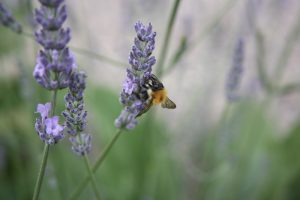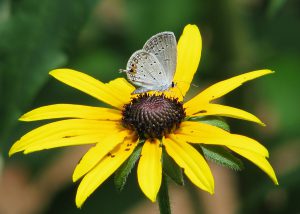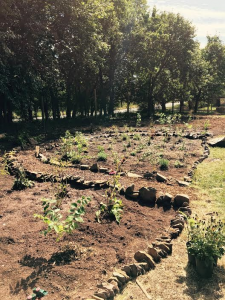Native Plants Transform Space into Rich Pollinator Habitat
By Kendall Miller, Project Coordinator
This fall, Conserve Wildlife Foundation partnered with Firmenich and GZA Environmental to provide pollinator plants to build an entirely new butterfly and rain garden on the Waldorf School campus in Princeton.
Firmenich volunteers stationed the plants around the garden and planted them on their annual global volunteer day. Plants include aromatic lavender, bright black-eyed susans and echinacea, shrubs like winterberry holly and spice bush, and trees such as common hackberry and sweet bay magnolia. These plants are all native to the local environment and provide essential nectar sources for pollinators.


From left to right, bee on lavender photo from Andrew Wilkinson through Flickr Creative Commons and eastern blue-tail visiting black-eyed susan Vicki Deloach through Flickr Creative Commons.
The space for the new garden was a previously fallow section of the school’s one acre garden. It was overgrown and somewhat sprawling until the project came about. Facilities manager Kevin Jones and gardening teacher Suzanne Cunningham both prepared the space for its transformation into a rich habitat of native plants.

Left. After planting, an unused and fallow area of the school’s garden is now home to several different types of native plants.
“Pollinators are in decline, which is very unfortunate since we rely on them as irreplaceable contributors to our health, our food, our environment, and our economy,” said David Wheeler, CWF Executive Director. “We are so thrilled to partner on this exciting and vital habitat project, particularly where the youngest generation can experience the beauty and vitality of nature first-hand.”
The native plants were provided by D&R Greenway Land Trust and Bountiful Gardens. CWF is working to expand native pollinator habitat across the state with leading corporate sustainability partners such as Firmenich and Atlantic City Electric.
The Waldorf School of Princeton has built three butterfly gardens, which serve to create a safe environment for local pollinators, such as monarch and swallowtail butterflies, honeybees, and hummingbirds. To this end, a honeybee colony has made it’s home in one of their trees and has grown to host over 2,000 wild honeybees! The school has been honored by the National Wildlife Federation as a Certified Wildlife Habitat, as well The Bronze Award from Eco-Schools USA program. They are certified from Monarch Watch as a Monarch Waystation.
The Waldorf School of Princeton is founded on principles of sustainability, environmental stewardship, and community cooperation. The school’s major green initiatives reflect the needs of their beautiful campus and the ability of their students to participate in the greening process. The Waldorf School of Princeton has the area’s oldest school garden, over 30 years old, which houses crops, herbs, flowers, and fruit trees.
LEARN MORE
Kendall Miller is a Project Coordinator with Conserve Wildlife Foundation.